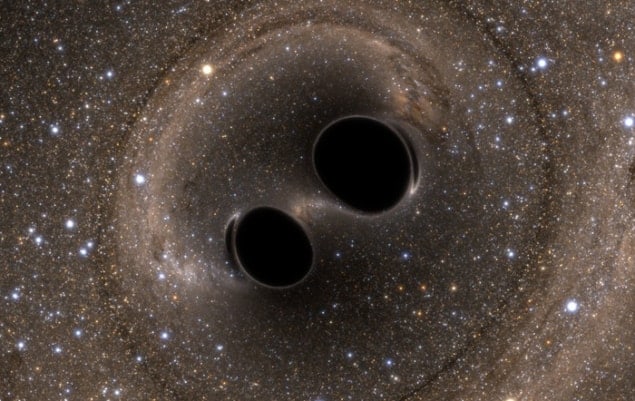
Gravitational-wave background noise created by merging back holes could be 10 times louder than had been expected, according to calculations by astrophysicists working on the LIGO and Virgo gravitational-wave detectors. Using information gleaned from LIGO’s recent detection of a gravitational wave, the team believes that the background noise is so loud that it could be measured by LIGO and Virgo in 2020, when the detectors are running at their full design sensitivities.
Earlier this year, the LIGO collaboration announced the first ever detection of a gravitational wave. The signal is believed to have been created by the merger of two black holes in an event dubbed GW150914. Similar mergers are expected to occur on a regular basis throughout the universe, but the vast majority of these events are too far away to be detected as distinct signals here on Earth. Instead, these events contribute to the gravitational-wave background that permeates the cosmos.
Astrophysicists are keen to study this noise because it could provide important information about black holes. Other astrophysical events such as merging neutron stars or black hole–neutron star mergers could also be contributing to the background noise, and precise measurements could reveal how common these binary systems are.
Rough estimates
To get a rough idea of how loud this background noise is, astrophysicists need to know how often black-hole mergers occur and how much mass the merging black holes are carrying when they collide. Until the discovery of GW150914, the existence and merger of binary black holes was purely theoretical, and this lack of real data made it very difficult to predict what the gravitational-wave background looks like.
But now astrophysicists have one data point to work with – GW150914 – and scientists on the LIGO and Virgo collaborations have used information gleaned from this breakthrough to estimate the strength of the gravitational-wave background. Central to their analysis is the idea that there is nothing special about GW150914 and the merger is average in every way.
The team assumed that the mass distribution of merging black holes is Gaussian in shape – having a strong central peak and tailing off at higher and lower masses. Because it is assumed to have an average mass, GW150914 must lie within the central peak of the distribution. This led the researchers to conclude that the population of black-hole binaries is about 20 times more massive than previously expected.
No luck involved
This information was then combined with an estimate of the rate at which black-hole mergers occur in the universe. Again, this was done by assuming that there was nothing special about the detection of GW150914. In other words, the team assumed that LIGO was not extremely lucky to have detected an extremely rare event. Knowing that LIGO was switched on for a certain period of time – during which it detected one merger – allowed the team to estimate that about 16 black-hole mergers occur per year, per cubic gigaparsec of space.
Putting all of this together, the team reckons that the gravitational-wave background is about 10 times louder than previously thought at frequencies around 25 Hz. This, the researchers say, means that it should be possible to measure the gravitational-wave background using the two Advanced LIGO detectors in the US and the Advanced Virgo detector in Italy, when they are all running at or near their full design sensitivity, which is expected to occur after 2019.
Signal correlations
LIGO collaboration member B S Sathyaprakash of the University of Cardiff in the UK explains that gravitational-wave background measurements are made by looking for correlations between signals measured by at least two detectors. This is done to eliminate noise that occurs locally in gravitational-wave detectors, and ensures that the measured signal is coming from the cosmos. “The first step will be to look for correlations in the two LIGO detectors,” he explains. Later this year, the upgraded Virgo detector near Pisa will join the search and there are other facilities planned for India and Japan.
Ultimately, astrophysicists would like to measure the amplitude of the noise as a function of frequency over the operating range of the detectors. This spectrum would provide important information about the mass distribution of black holes, and could even allow cosmologists to identify a component of the noise that was created by quantum fluctuations just after the Big Bang.
The calculations are described in Physical Review Letters.



